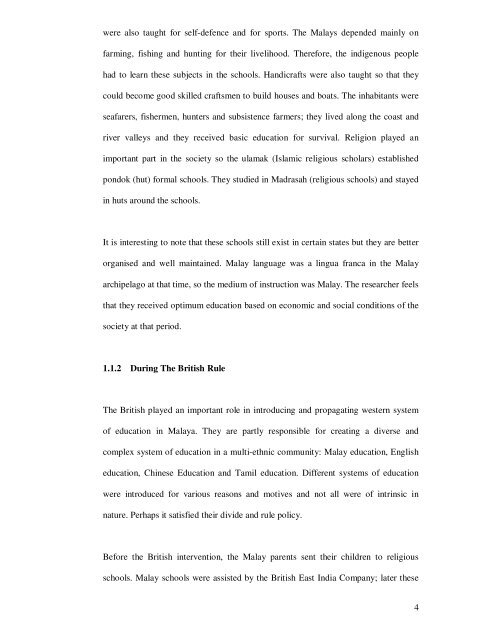CHAPTER 1 1.0 Introduction - DSpace@UM - University of Malaya
CHAPTER 1 1.0 Introduction - DSpace@UM - University of Malaya
CHAPTER 1 1.0 Introduction - DSpace@UM - University of Malaya
Create successful ePaper yourself
Turn your PDF publications into a flip-book with our unique Google optimized e-Paper software.
were also taught for self-defence and for sports. The Malays depended mainly on<br />
farming, fishing and hunting for their livelihood. Therefore, the indigenous people<br />
had to learn these subjects in the schools. Handicrafts were also taught so that they<br />
could become good skilled craftsmen to build houses and boats. The inhabitants were<br />
seafarers, fishermen, hunters and subsistence farmers; they lived along the coast and<br />
river valleys and they received basic education for survival. Religion played an<br />
important part in the society so the ulamak (Islamic religious scholars) established<br />
pondok (hut) formal schools. They studied in Madrasah (religious schools) and stayed<br />
in huts around the schools.<br />
It is interesting to note that these schools still exist in certain states but they are better<br />
organised and well maintained. Malay language was a lingua franca in the Malay<br />
archipelago at that time, so the medium <strong>of</strong> instruction was Malay. The researcher feels<br />
that they received optimum education based on economic and social conditions <strong>of</strong> the<br />
society at that period.<br />
1.1.2 During The British Rule<br />
The British played an important role in introducing and propagating western system<br />
<strong>of</strong> education in <strong>Malaya</strong>. They are partly responsible for creating a diverse and<br />
complex system <strong>of</strong> education in a multi-ethnic community: Malay education, English<br />
education, Chinese Education and Tamil education. Different systems <strong>of</strong> education<br />
were introduced for various reasons and motives and not all were <strong>of</strong> intrinsic in<br />
nature. Perhaps it satisfied their divide and rule policy.<br />
Before the British intervention, the Malay parents sent their children to religious<br />
schools. Malay schools were assisted by the British East India Company; later these<br />
4

















